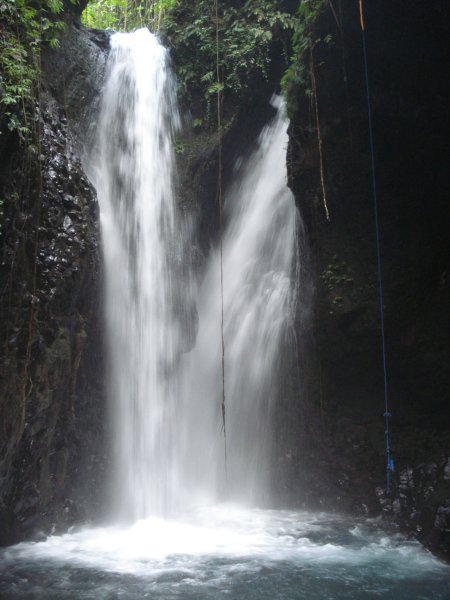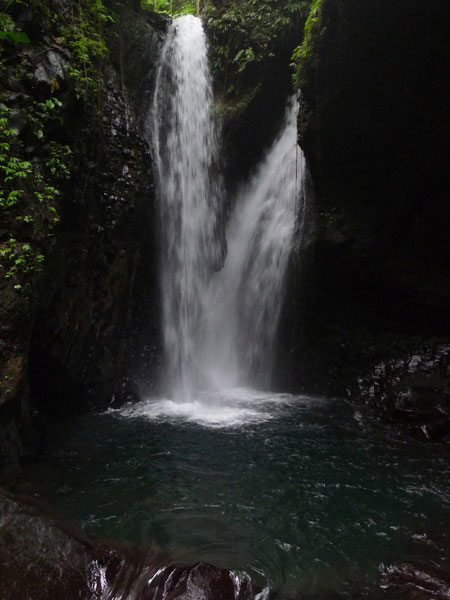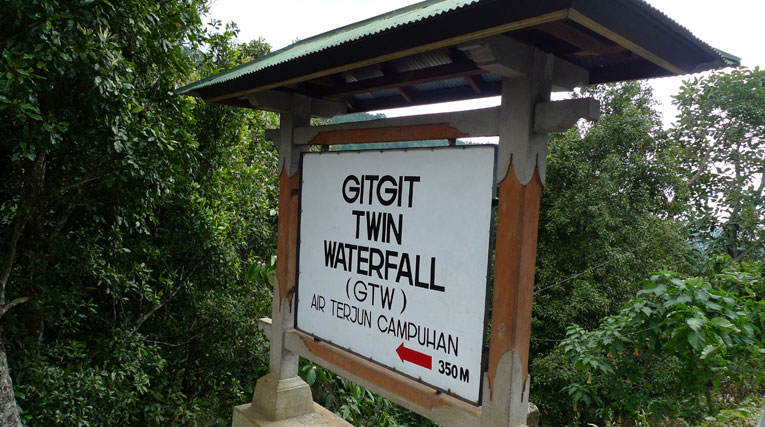Gitgit Twin Waterfall, Perfect to Admire the Beauty of Nature
There are 10 waterfalls in Buleleng regency. The one which is most visited by tourists is Gitgit Twin Waterfall. The name comes from the name of the village where the waterfall is located.
It takes around two hours to reach Gitgit Twin Waterfall driving from Denpasar to Buleleng Regency via Bedugul. The winding road after Candi Kuning Fruit and Vegetable Market toward Buleleng offers picturesque views of Buyan Lake and monkeys on the roadside. The monkeys are calm and not dangerous but can be a little bit aggressive if you feed them.
Entering Gitgit Village, the first waterfall is Gitgit Twin Waterfall on your left. Some say that the walk to this waterfall is a long downhill hike. Gitgit Waterfall, which is not too far from the turnoff to the Twin Waterfall.
From the parking area, there’s a 500 meter scenic walk where you can find some of the island’s common plantation crops such as cacao, coffee, clove and nutmeg. Some stalls selling handicrafts and spices line the concrete path to the ticket counter which stands amidst trees. Once you reach the ticket counter, it means that you are around 700 meters from the famous waterfall.
With paddy fields on your left and a green gorge on your right the walk to the waterfall is invigorating. The sound of the waterfall can be heard from 200 meters away and after a few more steps you can see a massive amount of water falling from a height of 45 meters and hitting the big stones below. The water is clear and cold, but in the rainy season is becomes brown as it is mixed with river sediment. Even though the water is cold, no matter what the season, people, both locals and tourists, often play in the water without any hesitation.
If you are ready for a more off the beaten track route and of course more walking and adventure, there is another waterfall above the Gitgit Waterfall. It is called Colek Pamor. Colek Pamor Waterfall is not a touristy area as it is far inside the jungle. There is no concrete path to reach this waterfall but a muddy narrow track used by locals to get to their farms. Cacao plantations, snake fruit trees, and bamboo are seen along the way. Before you reach the waterfall, you’ll first arrive at the top of Gitgit waterfall. The view from the top is splendid.
Following the river, crossing a simple bamboo bridge, and trekking a bit uphill, eventually you’ll find a broken shack with the sign Colek Pamor Waterfall. From this shack, you can only see a river with calm and pristine water and hear the sound of the water. Walk by the riverbank and after you pass a right curve you’ll find the waterfall. The waterfall drops from a height of 50 meters and the water comes from a round cave. The cave is a natural underground waterway that carries water from the Buleleng River to Gitgit. This waterfall is worth visiting. It’s the perfect place to admire the beauty of nature amid tranquil surroundings.
How to get to Gitgit Twin Waterfall :
1. 30 Minutes from Singaraja
2. 2 ½ hours from Denpasar
3. 1 ½ hours from Tabanan
What you can see around Gitgit Twin Waterfall :
1. Meduwe Karang Temple, One of northern Bali’s largest temples, its terraced entrance recalls some of Europe’s stately baroque gardens. Steps lead past 34 stone figures from the Ramayana to a big, peaceful, nearly empty courtyard. More steps lead to an inner section containing a huge stone pyramid like base flanked by two bale reserved for offerings.
2. Beji Temple, Some say this is the largest temple and Subak temple in North Bali. For local people this temple is known as Pura Subak; subak here refers to the organization for water supply or irrigation. Pura Subak is a holy place and here you can worship Dewi Sri the Goddess of rice and the symbol of prosperity.
3. Ponjok Batu Temple is a stone temple where all temple buildings are made from stone. This temple area own the wide area about 35 acre in form of black stones bank. The position of this temple is rather sticking out to the sea as a fore-land or Ponjok. Base on the position and condition then this place is named by Ponjok Batu so that the temple is standing above fore-land petrify and it is referred as Ponjok Batu Temple.
4. Lovina Beach (or often simply Lovina) is a coastal area on the northwestern side of the island of Bali, Indonesia. The coastal strip stretches from 5 Km west of the city of Singaraja to 15 Km west Singaraja is the seat of Buleleng regency. The Lovina area contains the small villages (from east to west) of Pemaron, Tukad Mungga, Anturan, Banyualit, Kalibukbuk, Kaliasem and Temukus. It is becoming more popular with tourists but remains far quieter than the tourist hotspots of the island’s south side.
  |
  |





